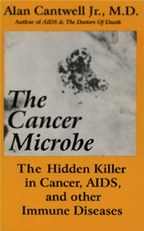- Hi Alan,
-
- This study hot off the press. Shows that components of
bacterial cell walls in Staphylococcus aureus play a role in promoting
and stimulating cancer invasiveness.Even more remarkable, the researchers
are suggesting the possible use of antibiotics in the treatment of CA!!
-
- What is fascinating, Livingston's demise, as you know,
came after sending incorrectly labeled samples of what she said was PC
to the American Cancer Society. Acevedo then shouted from the rooftops
- 'we found staphylococci NOT some weird bacterium (meaning Progenitor)'.
Yet, Livingston's samples still contained hCG producing bacteria which
are now being found to be directly connected to some forms of cancer. To
illustrate the point, it would be like saying that Livingston was dead
wrong because she believed there were aliens from Mars living in Los Angeles,
when in fact, the aliens living there were found to be from Pluto. She
still discovered the aliens.
-
- Anyway, please pass along as you see fit.
-
-
- Dear Ron:
-
- When my paper on bacteria in breast cancer was published
in 1981, I was concerned that the culture of Staphylococcus epidermidis
from skin metastatic samples would be greeted by derision.......now I am
glad I had the courage (audacity?) to report "staphylococci"
as a possible manifestation of the "cancer microbe". See the
abstract posted below.
-
- ALAN
-
-
- 2010 May 26;5(5):e10850.
-
- Bacteria peptidoglycan promoted breast cancer cell invasiveness
and adhesiveness by targeting toll-like receptor 2 in the cancer cells.
- Xie W, Huang Y, Xie W, Guo A, Wu W.
-
- Biology Research Institute of the United Laboratories
International Holdings Limited, Zhuhai, China. xiewj75@126.com
-
- Abstract
- Chronic bacterial infection increased the risk of many
solid malignancies and the underlying mechanism is usually ascribed to
bacterial-caused inflammation. However, the direct interaction of infectious
bacteria with cancer cells has been largely overlooked. We identified that
highly metastatic breast cancer MDA-MB-231 cells expressed high level of
Toll-like receptor 2 (TLR2) in contrast to poorly metastatic breast cancer
cells and homogenous untransformed breast cells. TLR2 in MDA-MB-231 cells
were actively triggered by peptidoglycan (PGN) from infectious bacterium
Staphylococcus aureus (PGN-SA), resulting in the promoted invasiveness
and adhesiveness of the cancer cells in vitro. PGN-SA induced phosphorylation
of TAK1 and IkappaB in the TLR2-NF-kappaB pathway of the cancer cells and
stimulated IL-6 and TGF-beta secretion in MDA-MB-231 cells. All these effects
were abrogated by TLR2 blockade. Further investigation showed that the
NF-kappaB, STAT3 and Smad3 activities were augmented sequentially in MDA-MB-231
cells after PGN-SA stimulation. Phosphorylation of NF-kappaBp65 was initially
increased and then followed by phosphorylation of STAT3 and Smad3 in the
delayed 4 or 6 hours. NF-kappaB inhibition attenuated STAT3 and Smad3 activities
whereas PGN-SA-stimulated cell culture supernatants reversed these inhibitory
effects. Our study indicated that TLR2 activation by infectious bacterial
PGN played an important role in breast cancer cell invasiveness and illustrated
a new link between infectious bacteria and the cancer cells, suggesting
the importance of antibiotic therapy to treat cancer with bacterial infection.
-
-
- J Dermatol Surg Oncol. 1981 Jun;7(6):483-91.
- Microbial findings in cancers of the breast and in their
metastases to the skin. Implications for etiology.
- Cantwell AR Jr, Kelso DW.
-
- Abstract
- In four cases of carcinoma of the breast, variably acid-fast
coccoid forms were found in sections from their metastases to the skin
and in one of these cases in sections of the primary carcinoma. In this
one case, similar-appearing corcoid forms were observed within the sections
of the primary malignancy. In this same case, Staphylococcus epidermidis
was cultured and studied at once and as it aged for development of forms
comparable to those found in the microscopic sections of the neoplastic
process. The implications of the findings for etiology of carcinoma of
the breast are discussed.
- PMID: 6166642 [PubMed - indexed for MEDLINE]
-

-
-
- Alan Cantwell M.D.
- alancantwell@sbcglobal.net
-
- author of THE CANCER MICROBE
-
- www.ariesrisingpress.com
|
